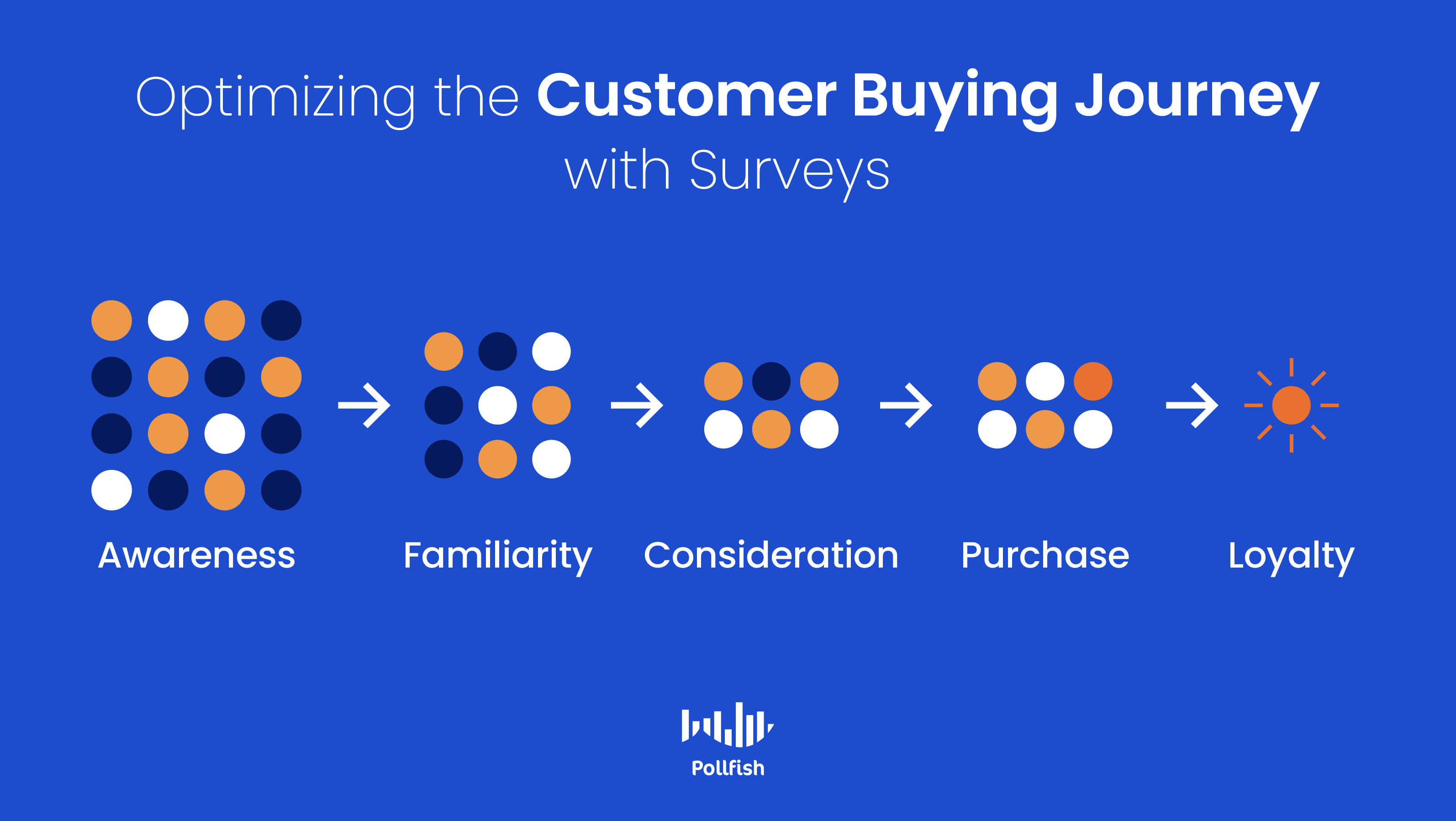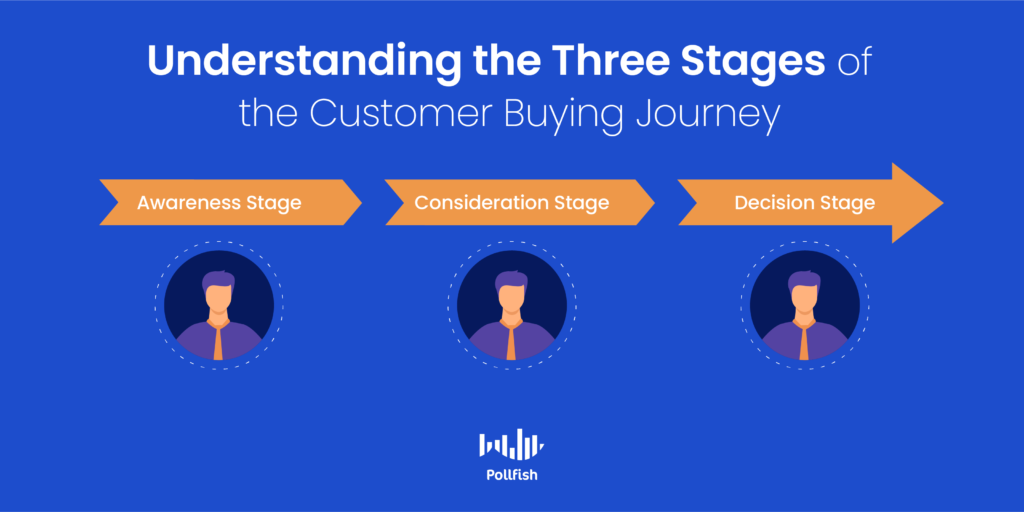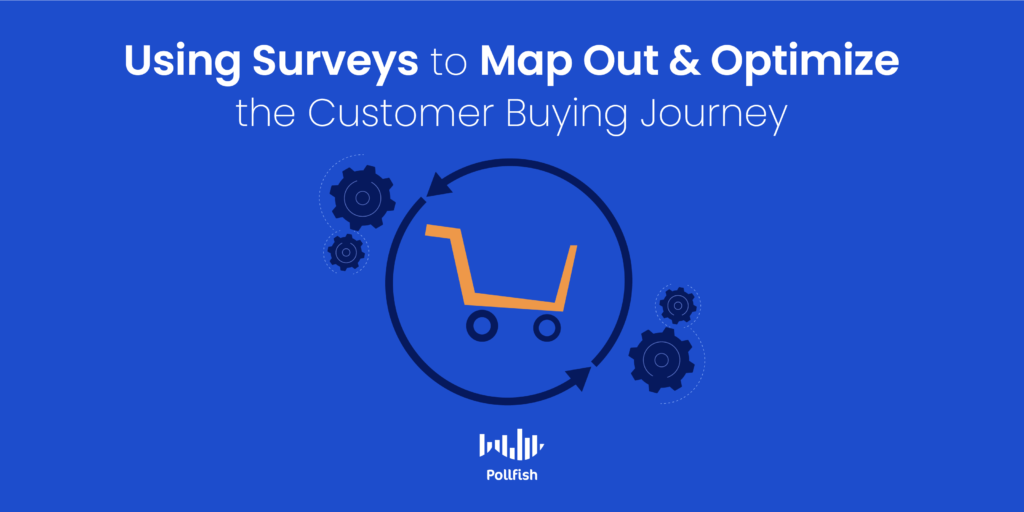Optimizing the Customer Buying Journey with Surveys

To properly execute their strategy, businesses need to study their customer buying journey, adapt to it and optimize it so that customers experience a quicker path to purchase.
Marketing and market research departments, therefore, need to actively engage in their sales cycle to optimize their customer journeys.
Given that shoppers today have a wealth of information within reach, it affects their customer buying behavior and in turn, their buying journeys. 67% of the customer buying journey takes place digitally. Businesses can take advantage of this digitized shopping, by nurturing and studying their target market online.
Surveying customers as they meander through their buying journey is a solid technique to better understand them, their thought process and their buying journey.
This article delves into the customer buying journey, explaining its importance, its three main stages, how survey research can help optimize this journey and more.
Understanding the Customer Buying Journey
This concept refers to the customer’s path to making a purchase. The customer buying journey is a process in which customers become aware of, examine evaluate and make the decision to purchase a new product or service.
This occurs, as most customers do not suddenly decide to purchase something on a whim; rather they consciously wade through three main stages that make up the typical customer buying journey. These stages are the awareness, consideration and decision stages.
The customer buying journey is essentially an active kind of research process that customers participate in before they make a purchase. During this journey, they encounter both customer and brand experiences, both of which impact the course of their journey, along with the customers’ final decision.
In a nutshell, this process involves everything that a customer would need to do before deciding whether or not to purchase from a business.
The Importance of the Customer Buying Journey
The buying journey holds an abundance of importance for businesses and customers. Businesses can take advantage of it by providing value and answers to customers at each stage. By doing so, they can successfully nurture customers to decide to buy from them.
By mapping out a customer journey and studying it, businesses can avoid making mistakes, such as those that come from traditional approaches, including waiting for customers to be ready or using a hard sales pitch.
Businesses can instead take the approach of giving customers all that they need based on the stage in their journey and steering them towards the business. Businesses can also use the buying journey stages to build trust with customers, rather than forcefully egging them on to buy.
This is important, as trust has a massive influence on customers. Nurturing potential customers according to their position in the buying journey gives brands a high potential to build trust, thereby later converting their prospects into customers.
Additionally, the customer buying journey is important because it offers a strategic approach to better understanding customer needs and expectations. When market researchers map out and study this process, they are far better equipped to provide their customers with a good customer experience (CX). CX alone is largely important, as 86% of customers will pay more for a better customer experience.
However since customer expectations are constantly shifting for all businesses, regardless of their size, all businesses must pay attention to their customer behavior in their buying journeys. Becoming attuned to this journey enables businesses to understand their target market better, giving them the advantage to optimize their customer buying journeys and win over leads.
Mapping the customer journey also includes the benefit of allowing businesses to improve and accelerate their customer onboarding process. This will allow new customers to get acquainted with and begin using a new product more efficiently and with ease. A quickened customer onboarding process delivers value to customers much sooner, granting them more fulfilling product satisfaction.
Moreover, studying the buying journey enables brands to understand the key differences in their customer personas as they move through the stages of the buying journey. Not every persona can feasibly convert from a prospect to a paying customer through the same efforts. As such, businesses should be aware of their customer journeys within all of their customer segments.
All in all, the buying journey is an increasingly important framework that all businesses should use to outline their marketing and strategic planning process, as it can improve sales.
The Three Stages of the Customer Buying Journey

As aforementioned, this journey is composed of three main stages: awareness, consideration and decision stages.
When planning out marketing strategies, businesses need to lay out this process for each of their customer personas. That way, the content and other marketing collateral they produce will be useful for each persona at every stage.
The following explains the three stages of the buying journey:
The Awareness Stage
In this stage, customers become aware that they have a problem. As a means of addressing the problem, customers will search the web for resources. These include consuming content on the cause of the problem.
While reading through this kind of content, which can include blogs, videos, infographics and articles, the customers identify the source or core of their problem. As such, at the end of this stage, customers often leave with a new sense of their true problem, meaning that it may be slightly or entirely different than their original problem.
To adapt to this stage, brands ought to focus on content that addresses customer pain points, which can help customers extract more issues related to their problem (that your business can solve).
Brands should implement industry-focused content and social media to grant an authoritative point of view. Advertising and PR that make mention of the customers’ problem is also necessary for this stage.
The Consideration Stage
In the middle stage, customers define their problem after narrowing it down in the previous stage and consider their options to solve it. In this stage, customers become solution aware, as they evaluate specific products and services and consider different buying criteria.
To adapt to this stage, businesses should show prospects what it is like to use their products and services specifically, focusing on how they provide solutions.
As such, they should use the following marketing collateral and content to nurture prospects in this stage: webinars, case studies, demos, vendor comparisons and trials, along with offers to entice customers to a brand, such as free samples and trials.
The Decision Stage
In the final stage, customers understand the solution they need and just have to decide on which provider, product, or service to use to carry out their solution. It involves customers deciding on their purchase; as such, it often includes speaking with a salesperson, especially in B2B industries.
In this stage, customers are provider-aware; for brands to adapt to this stage, they need to understand the objections that their prospects may have and handle them immediately.
They also need to provide their customers with a unique selling proposition. This will show customers how a business offers value to them and what sets the brand apart from its competitors.
By this stage, the potential customers will have done all the research to be well informed on the services that will fit their needs best, along with the companies they believe are most suitable. As such, businesses must prove their superiority through customer reviews, testimonials and case studies.
Additionally, any content that posits a business as the better choice over a competitor is necessary to persuade potential customers to buy.
How Surveys Optimize the Customer Buying Journey

Optimizing this journey involves understanding your customers at a granular level, especially as it concerns their purchasing behaviors, as every customer persona, let alone an individual customer, is different.
No matter how well a business understands its customers — whether it involves their lifestyle, demographics, opinions, wants, or needs — these aspects are subject to change. With new technologies, innovations to products and changes to services, customers acclimate and change alongside them.
Businesses must follow suit by keeping up with not only the changes within their industry but also their customers’ reactions and subsequent behavior in light of those changes. Surveys are the most equipped tools for garnering granular and up-to-date customer insights.
That’s because, with surveys, businesses can obtain customer feedback within all the stages of the customer buying journey. Moreover, surveys equip businesses with a deep understanding of their customer segments, allowing them to perform market segmentation and identify customer personas.
With these insights in tow, businesses can map out the customer buying journey for each of their customer segments and personas, creating a more personalized experience, which is key to a good CX.
Businesses can also survey their customers on their experience and expectations in each stage of their customer buying journey. This will ensure that they are properly marketing to them, answering key questions and setting themselves apart in a competitive setting.
Surveys also provide insight into customers’ specific problems, showing businesses how they can innovate and perfect their existing products, services and experiences. As such, surveys are the lynchpin to understanding a target market, allowing businesses to optimize each stage of their buying journey.
Being Attuned to Customers in an Omnichannel Setting
Customers seek highly personalized experiences as they wade through their customer buying journey. They reach a particular brand through various channels in their buying journey, which is known to brands as using the omnichannel approach.
To deliver a viable omnichannel approach, businesses must map out their customer buying journeys for various customer segments and personas. To do so aptly, they need to use surveys, as explained above. However, they must decide on a robust online survey platform to obtain valuable results.
To do so, they ought to use an online survey platform that offers a user-friendly interface for creating and deploying surveys to a massive network across websites, mobile sites and apps.
A strong survey tool offers advanced skip logic to route respondents to relevant follow-up questions, implements quality data checks via artificial intelligence and machine learning, offers a wide range of filtering data options, engages respondents in their natural digital environments via random device engagement (RDE) sampling and much more.
With such an online survey platform, businesses can easily glean insights into their customer preferences and buying habits, allowing them to accurately map out their customer buying journey and optimize it to increase their revenue.
Do you want to distribute your survey? Pollfish offers you access to millions of targeted consumers to get survey responses from $0.95 per complete. Launch your survey today.
